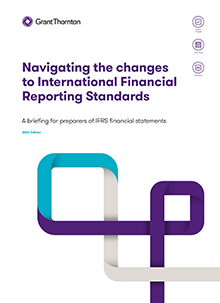-
IFRS
At Grant Thornton, our IFRS advisers can help you navigate the complexity of financial reporting.
-
Audit quality monitoring
Having a robust process of quality control is one of the most effective ways to guarantee we deliver high-quality services to our clients.
-
Global audit technology
We apply our global audit methodology through an integrated set of software tools known as the Voyager suite.
-
Supply Chain and Operation Services
An optimised and resilient supply chain is essential for success in an ever-evolving business landscape
-
Business risk services
The relationship between a company and its auditor has changed. Organisations must understand and manage risk and seek an appropriate balance between risk and opportunities.
-
Marketing and Client Service
We offer strategy, client service, digital and insight solutions to businesses that are shaping the future across the Middle East.
-
Forensic services
At Grant Thornton, we have a wealth of knowledge in forensic services and can support you with issues such as dispute resolution, fraud and insurance claims.
-
Deal Advisory
At Grant Thornton, we deliver deal advisory services through a strategic lens, providing end-to-end support that enables our clients to unlock value, manage risk, and make informed decisions with confidence. Our team works closely with businesses across Saudi Arabia to navigate the complexities of transactions and drive smart, sustainable outcomes.
-
Growth services
We have designed and developed growth services to support your business at each phase of its growth. So whether you are an SME that has just set up or a large business wishing to expand, at Grant Thornton we will help you unlock your potential for growth.

The 2022 edition of the publication has been updated for changes to International Financial Reporting Standards (IFRS) that were published between 1 January 2021 and 31 December 2021.
The publication now covers 31 March 2021, 30 June 2021, 30 September 2021, 31 December 2021 and 31 March 2022 financial year ends.
Identifying the changes that will affect you
Effective dates of new standards
-
Various: Amendments to references to the conceptual framework in IFRS Standards - 1 January 2020
-
IFRS 3: Definition of a Business (Amendments to IFRS 3) - 1 January 2020
-
IAS 1 and IAS 8: Definition of Material (Amendments to IAS 1 and IAS 8) - 1 January 2020
-
IFRS 9, IAS 39 and IFRS 7: Interest Rate Benchmark Reform (Amendments to IFRS 9, IAS 39 and IFRS 7) - 1 January 2020
-
IFRS 16: COVID-19-Related Rent Concessions (Amendment to IFRS 16) - 1 June 2020
-
Various interest rate benchmark reform phase 2 - 1 January 2021
-
IFRS 16: COVID-19 related rent concessions - 1 April 2021
-
IFRS 3: References to the Conceptual Framework (Amendments to IFRS 3) - 1 January 2022
-
IAS 16: Proceeds before intended use - 1 January 2022
-
IAS 37: Onerous Contracts – Cost of Fulfilling a Contract (Amendments to IAS 37) - 1 January 2022
-
IFRS 1, IFRS 9, IFRS 16 and IAS 41: Annual Improvements to IFRS Standards 2018-2020 Cycle - 1 January 2022
-
IFRS 17: Amendments to IFRS 17 - 1 January 2023
-
IFRS 4: Extension of the temporary exemption from applying IFRS 9 - 1 January 2023
-
IFRS 17 Initial Application of IFRS 17 and IFRS 9 – Comparative Information - 1 January 2023
-
IAS 1: Classification of Liabilities as Current or Non-current - 1 January 2023
-
IAS 12: Deferred Tax related to Assets and Liabilities arising from a Single Transaction - 1 January 2023
The effective dates table in the article has been colour coded to help entities planning for a specific financial reporting year end, and identifies:
- changes mandatorily effective for the first time
- changes not yet effective
- changes already in effect.
Where a change is not yet mandatorily effective for a particular year end, it may still be possible for an entity to adopt it early (depending on local legislation and the requirements of the particular change in concern).
Where a change has been made but an entity is yet to apply it, certain disclosures are required to be made under IAS 8 ‘Accounting Policies, Changes in Accounting Estimates and Errors’. Disclosures required include the fact that the new or amended Standard or Interpretation has been issued but it has not yet been applied, and known or reasonably estimable information relevant to assessing its possible impact on the financial statements in the period of initial application.
Identifying the commercial significance of the changes in the publication
For each change covered in the publication, we have included a box on its commercial implications. These sections focus on two questions:
- how many entities will be affected?
- what will be the impact on affected entities?
A traffic light system indicates our assessment of the answers to these questions.
